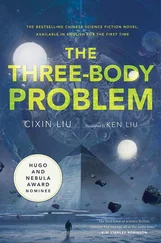Luo Ji’s living quarters took up the whole of the tenth basement floor. While it was no match in comfort for the house he had just left, it was equipped with comprehensive communications and computer equipment, along with a conference room set up with a remote video conferencing system, giving the place the feel of a command center.
The administrator made a particular point of showing Luo Ji a set of light switches in the room, each of which bore a small picture of the sun. The administrator called them “sun lamps” and said they needed to be turned on for no fewer than five hours a day. Originally intended as labor-safety products for mine workers, they could simulate sunlight, including UV rays, as supplementary daylight for people spending long periods underground.
The next day, as Luo Ji had requested, the astronomer Albert Ringier visited the tenth basement.
When he saw him, Luo Ji said, “You were the first to observe the flight path of the Trisolaran Fleet?”
Ringier looked a little unhappy to hear this. “I’ve repeatedly issued statements to reporters, but they insist on forcing this honor on my head. It should be credited to General Fitzroy. He was the one who demanded that Hubble II observe Trisolaris during testing. Otherwise we might have missed the chance, since the wake in the interstellar dust would have faded.”
“What I’d like to talk to you about isn’t connected to that. I did a bit of astronomy once, but not in much depth, and I’m no longer familiar with the subject. My first question is this: If, in the universe, there exists another observer apart from Trisolaris, has Earth’s position been revealed to them?”
“No.”
“You’re sure of that?”
“Yes.”
“But Earth has exchanged communication with Trisolaris.”
“That low-frequency communication would reveal only the general direction of Earth and Trisolaris in the Milky Way Galaxy, and the distance between the two worlds. That is, if there’s a third-party recipient, the communication would make it possible for them to know of the existence of two civilized worlds 4.22 light-years apart in the Orion Arm of the Milky Way, but they would still be ignorant of the precise position of those two worlds. In fact, determining each other’s position through this kind of exchange is only feasible for stars in close proximity, like the sun and the stars of Trisolaris. For a slightly more distant third-party observer, however, even if we communicate directly with them, we wouldn’t be able to determine each other’s position.”
“Why is that?”
“Marking the position of a star for another observer in the universe is hardly as easy as people imagine. Here’s an analogy: You’re taking a plane through the Sahara Desert and a grain of sand below you shouts ‘Here I am!’ You hear the shout, but can you fix a location for that grain of sand from the plane? There are nearly two hundred billion stars in the Milky Way. It’s practically a desert of stars.”
Luo Ji nodded in apparent relief. “I understand. So that’s it, then.”
“What is?” Ringier asked in confusion.
Luo Ji didn’t answer, but asked instead, “Using our present level of technology, is there a way to indicate the position of a star in the universe?”
“Yes, by using directed very high frequency electromagnetic waves, equal to or higher in frequency than visible light, and then harnessing stellar power to transmit information. In simple terms, you’d make the star flash, like a cosmic lighthouse.”
“This far exceeds our present technical capabilities.”
“Oh, I’m sorry. I overlooked your precondition. At our present technical capabilities, it would be fairly difficult to show a star’s position to the far reaches of the universe. There’s still a way, but interpreting the positional information requires a level of technology far beyond that of humanity, and even, I believe, beyond that of Trisolaris.”
“Tell me about that approach.”
“The key information is the relative position of stars. If you specify a region of space in the Milky Way that contains a sufficient number of stars—perhaps a few dozen would be sufficient—their relative arrangement in three-dimensional space would be totally unique, like a fingerprint.”
“I’m starting to understand. We send out a message containing the position of the star we wish to point out, relative to the surrounding stars, and the recipient compares the data to its star map to determine the star’s location.”
“Right. But things aren’t that simple. The recipient must possess a three-dimensional model of the entire galaxy that precisely indicates the relative position of every one of a hundred billion stars. Then, after receiving our message, they would have to search through that enormous database to find an area of space that matches the pattern of positions we sent out.”
“No, it’s not simple at all. It’s like recording the relative position of every grain of sand in the desert.”
“Even harder than that. The Milky Way, unlike the desert, is in motion, and the relative positions of its stars are constantly changing. The later the position information is received, the greater the error caused by these changes. This means the database has to be able to predict the changes in position of each of those hundred billion stars. In theory, it’s not a problem, but to actually do it… God…”
“Would it be hard for us to send that positional information?”
“No, because we would only need to have a position pattern for a limited number of stars. And now that I’ve had time to think about it, given the average stellar density of the outer arm of the galaxy, a position pattern with no more than thirty stars should be sufficient. That’s a small amount of information.”
“Good. Now I’ll ask a third question: Outside the Solar System, there are other stars with planets. You’ve discovered several hundred, right?”
“More than a thousand to date.”
“And the closest to the sun?”
“244J2E1, sixteen light-years from the sun.”
“As I remember it, the serial numbers are set like this: the prefix digits represent the order of discovery; the letters J, E, and X stand for Jupiter-type planets, Earth-type planets, and other planets, respectively; and the digits following the letter indicate the number of that type of planet in the system.”
“That’s right. 244J2E1 is a star with three planets, two of them Jupiter-type and one Earth-type.”
Luo Ji thought for a moment, then shook his head. “That’s too close. How about a little farther, like… around fifty light-years?”
“187J3X1, 49.5 light-years from the sun.”
“That one’s fine. Can you draw up a position pattern for that star?”
“Of course I can.”
“How long would it take? Would you need help?”
“I can do it here if there’s a computer with Internet. For a pattern of, say, thirty stars, I can give it to you tonight.”
“What time is it now? It’s not nighttime already?”
“I’d say it’s probably morning, Dr. Luo.”
Ringier went to the computer room next door, and Luo Ji called in Kent and Zhang Xiang. He first explained to Kent that he wanted the PDC to hold the next Wallfacer hearing as soon as possible.
Kent said, “There are lots of PDC meetings these days. Once you’ve submitted the application, you’ll probably only have to wait a few days.”
“Then I’ll have to wait. But I’d really like it as soon as possible. Also, I have a request: to attend the hearing here via video rather than go to the UN.”
Kent looked reluctant. “Dr. Luo, don’t you think that’s a little inappropriate? For such a high-level international meeting… It’s a question of respect for the participants.”
Читать дальше












